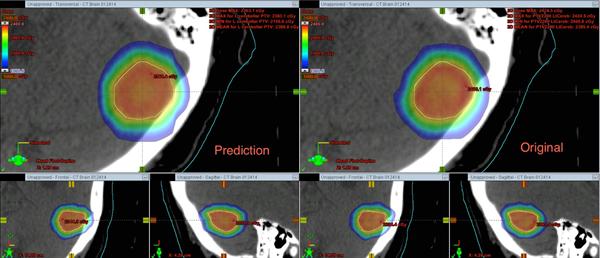Method To Predict Three-Dimensional Radiotherapy Dose Distribution
Background
A painting is not the amount of blue, yellow, and red paint on a canvas; it is their arrangement that makes it art.
The advent of knowledge-based planning (KBP) represents a critical step forward in clinical radiotherapy, comfortably mentioned in the company of the other major advances in treatment planning (2D àà 3D-conformal àà IMRT/RapidArc àà KBP). While incredibly powerful, current knowledge-based methods result in dose-volume histogram (DVH) predictions that are ultimately limited by the inherent loss in spatial information of a DVH. In current incarnations of KBP (e.g. Varian’s RapidPlanTM), these predictions must be converted into DVH-based optimization parameters to enact automated planning, and when treatment plan DVHs differ from their knowledge-based DVH predictions it requires significant expertise to discern the origin of the deviation. Troublingly, the investigation and resolution of these discrepancies necessarily falls into the hands of the same human treatment planners that knowledge-based planning purports to outperform.
Technology Description
At UC San Diego, we have developed a major advance in knowledge-based treatment planning: full 3D dose distribution prediction. Similar to existing art1 our method relies on learning from a plurality of previously treated plans, but our method moves far beyond current technology to synthesize past experience into voxel-by-voxel predictions for expected dose distributions for new patients. Our current embodiment already meets or exceeds the accuracy of existing technology in DVH prediction, with the invaluable addition of identifying (a) precisely where the dose is expected to be deposited in the patient and (b) the degree of confidence in that voxel-by-voxel prediction.

1 See in particular US20120310615 (on which Dr. Kevin
Moore was the lead inventor) and US20120014507.
Applications
This technology opens up a number of new possible applications in treatment planning optimization and plan evaluation. Some of these include:
· Immediately after contour approval, radiation oncologists would have an expected treatment plan dose distribution to review, both guiding and accelerating the clinical decision making process for fractionation, target/organ prioritization, etc.
· Treatment planners would have a powerful new diagnostic tool for understanding exactly where sub-optimal plans are failing, increasing efficiency and further eliminating human failure from the planning process.
· New voxel-based optimization methods could be designed around these predictions, eliminating the need to convert DVH predictions to DVH-based optimization objectives and relative priorities.
It is possible that this technology will herald yet another huge leap forward in clinical treatment planning, and in time the history of treatmentplanning advances could seen as:
2D àà 3D-conformal àà IMRT/RapidArc àà 1D-KBP àà 3D-KBP.
Patent Status
| Country | Type | Number | Dated | Case |
| United States Of America | Published Application | 20170340900 | 11/30/2017 | 2015-046 |
Contact
- University of California, San Diego Office of Innovation and Commercialization
- innovation@ucsd.edu
- tel: View Phone Number.
Other Information
Keywords
radiotherapy, knowledge-based planning, KBP
